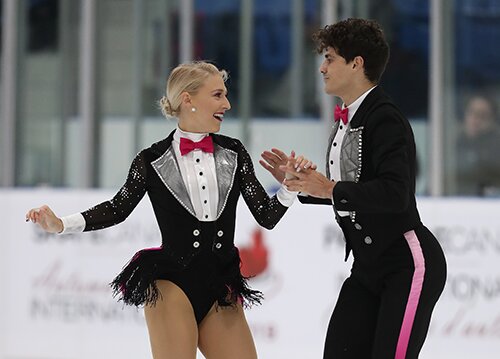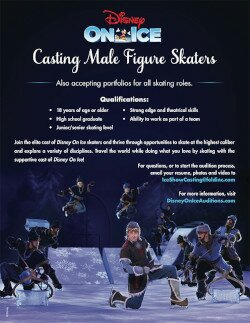

It has been a long and sometimes rocky road for Piper Gilles and Paul Poirier as they made the slow climb to the top of the ice dance ladder. But the results last season have boosted the confidence of this dynamic duo, who now believe they have the right plan and the competitive mindset to challenge the best.
As Canada’s Piper Gilles and Paul Poirier drew ever closer to the summit of the ice dance world, they could see themselves on the same level as the sport’s best — but there was still something missing, something they felt was holding them back.
It was certainly not the material they were bringing to the ice — their programs remain among the most innovative on the circuit — or their drive to be the best at what they do. Surely, that is a desire that has never been lacking in either of them. But there is one element that beats strongly in the heart and especially in the mind of any champion. And that is the unassailable belief that it can happen, that you belong in any discussion of the very best in your sport. And when that moment presents itself, you seize upon it and make it yours.
Slowly but surely, Gilles and Poirier are getting to that point. There have been certain signposts along the way this season that have proven significant in building that sense of self-belief. Their first Grand Prix triumph, a return to the Grand Prix Final for the first time in five years, and the long-awaited Canadian title that had eluded them … each and every one of those moments have contributed to a confidence level that grows with each passing day.
And so, there was an understandable excitement — and perhaps a little relief — in the moments after their victory at the 2020 Canadian Championships in January. After all, Gilles and Poirier had played the bridesmaids for far too long, with a collection of medals that include five silver and two bronze. Finally, with this triumph, there was a golden moment to celebrate.
Gilles and Poirier are very much aware of the history of ice dance in their country, and the Olympic and World champions that preceded them. They feel honored to be in such company. “There’s such a beautiful history of ice dance in Canada and to be part of that book of Canadian ice dance champions is definitely an exciting thing. It’s something that we really wanted,” said Poirier.
Carol Lane, the team’s long-time coach, along with Juris Razgulajevs and Jon Lane, touched on the importance of that very subject as she assessed Gilles and Poirier’s winning performance. “They have to keep pushing themselves. They have to keep extending everything they do to the max — and they are,” said Lane. “They have to believe in themselves. What this weekend has done for them is that they understand now they can do it. This was a huge boost for them confidence wise. It’s a very true thing: you have to skate like a champion before you can be a champion. That’s what they did.”
Razgulajevs took it one step further, producing another ‘seeing is believing’ moment that he thought was critical. He pointed to the program components section of the judges’ score sheet for their free dance, which contained 19 perfect 10.0s, with one judge giving them a full set across the board.
That was done, like many things this season, with a definite intention, and it had its effect on Gilles and Poirier. “To me, every year they are the best,” said Razgulajevs. “I showed them they got 10s in components. That’s a big step for them. They were like ‘Oh, OK, I guess we are good.’ It showed the world where they are at the moment.”
“Their scores were substantial …there’s a message in that, and in ice dance that’s very important,” Lane added.
LEARNING CURVES
All of that provided further reinforcement to the biggest takeaway Gilles and Poirier were left with following the 2019 World Championships in Japan. Having brought home a medal from every competition they entered last season, the duo went to Saitama with high hopes. A seventh-place finish was not what they had in mind but, on reflection, they now know where and why they faltered.
“We learned that we needed to believe in ourselves a little more,” said Gilles, 28. “There were times last year where we were totally prepared, and we let ourselves overdo it and did not skate to our ability. We took that as a learning experience and we have gone in to every competition so far this season and said, ‘OK, this is the program we are going to skate today. No more, no less,’ and I think we now expect that from ourselves. But you can’t learn that stuff until things go wrong.”
Both skaters expressed the belief that last year they “over-trained” in the weeks between the Four Continents and World Championships, and that led to a feeling of exhaustion when it came to the free dance. It also led them to take what Poirier called a more “intentional” approach to their training this season. “We really focused a lot of attention on that,” said Poirier, 28. “We set up our fall season so that we would have five weeks between our first Challenger Series event (Autumn Classic International) and Skate Canada, which was the exact same frame of time between Four Continents and Worlds.
“That way, we sort of practice, ‘what is that five weeks of training going to look like, and how do we feel after it?’ We felt really good at Skate Canada and we performed really well at that competition, so we feel really confident in that plan. It has been really intentional about having the right preparation so that we are well set up for success. That served us well through the Grand Prix season. We had solid performances, we were very consistent and that’s been a really important thing for us.”
Lane believes it just might be the training plan that can carry them all the way to the 2022 Olympic Winter Games in Beijing, China, where Gilles and Poirier are targeting a podium finish — at the very least. “What they have done really well this year is stick to the plan,” said Lane. “We have worked to a specific plan and they have been able to stick to it. We’ve been lucky— touch wood — that they have been healthy pretty much all the way through. So now we are putting that training method in place for the Olympics. If we follow it through and it works, we’re hopeful it will take us through the next two seasons. We have really identified that as a key area and we want to do it that way. That is what has worked really well for them so far.”
PROGRAMS FOR THE PEOPLE
Another challenge Gilles and Poirier faced this season — at least from an outsider’s perspective — was how to follow up on “Vincent,” the immensely popular free dance the duo presented during the 2018- 2019 campaign.
It was perhaps the signature program of their career to date, and a year later it is one that has stuck with many of their fans. Gilles and Poirier are using it as their exhibition program this season and have received numerous messages of gratitude from fans for doing so. And so it seemed that their current free dance — “Both Sides Now,” by Canadian music legend Joni Mitchell — was almost a natural next step.
Lane’s suggestion of “Both Sides Now” touched a nerve with them almost immediately. “They loved it. As soon as we took the music to them, they were like ‘Oh, we’re good with that,’” said Lane, adding she sees the Mitchell piece as the right evolution for her students, a step they could not have taken without succeeding with “Vincent.”
“It’s a funny thing to say, but it actually wasn’t a challenge,” said Lane with respect to the signature program. “I just didn’t want to get bogged down in ‘Oh, you’ll never top ‘Vincent;’ nothing will ever be as good as that. Nothing will ever have as special a place in my heart as that because it really showed what they could do, and it showed us a whole other side of them. Without having done that program, they could never have done this one the way that they are doing it. I thought myself I would never love anything as much as ‘Vincent,’ but they’re living inside this one, almost more than they did with that program. Just that whole new level of confidence has taken the ‘Both Sides Now’ program and made it a stunning vehicle for them.”
Gilles and Poirier both say the emotional investment that was required to pull off “Vincent” has helped them see every side of their current free dance. “We asked ourselves, ‘what do we want to do now?’ And what we wanted to do this season was a Canadian program in Canada. That’s really all we took into consideration,” Poirier recalled. “We just did the program we wanted to do this season, and that allowed us to explore the emotions and the themes we wanted to explore. I think, generally, what ‘Vincent’ did teach us was that we need to create programs that allow people to believe in what we are doing. That is sort of why we have had this theme ‘programs for the people’ for the free dances this quad.
“We want to do programs that people can connect with, that sort of have these universal themes and are very easily accessible. We thought Joni’s music was good for that, for having lyrics that talk about life and about experiences that we all have.”
If Gilles and Poirier needed validation for their music choices — their rhythm dance is set to another classic piece, “Mack and Mabel” — and their new approach to training, they got it at Skate Canada last October. There, they produced personal best scores across the board, including a 209.01 total that gave them their first gold medal at a Grand Prix competition. Find a video clip of the scene in the kiss and cry when the final marks were posted, and the look on Gilles’ face will tell you all you need to know about the importance of that triumph.
Winning the free dance pushed Gilles and Poirier past Madison Hubbell and Zachary Donohue, the 2019 World bronze medalists, in the final standings. While the Canadians had beaten their American rivals at Four Continents a year ago, where Gilles and Poirier got a big assist from a major mistake on a lift by the U.S. team, this time, it was a straight-up win. “It really did feel like an attainable goal for us to win a Grand Prix event,” said Poirier. “We wanted to win, we wanted to be at the Final. We want to be winning everything. That’s how we need to approach our competitions now if we hope to get the results that we want. It was a really big milestone for us to have a Grand Prix title.”
Gilles said she and Poirier knew they were capable of beating the American team, “but at the end of the day we had to beat ourselves mentally. We always need to be in that right mind frame. We are very, very proud of the work that we have done.
“This sport is all about timing, and we’re at the point in our career where we are not going to just sit back and let everyone say, ‘Oh, good program’ and we say, ‘Oh, go ahead, beat us, please.’ We have a couple of more years, hopefully, and we don’t want to be the team where people say, ‘good programs, but no results.’ We want to have those results and we want to be on top of the podium, or else there is no point in it for us. We are older and we know that there are a lot of younger teams coming up. We want to have those medals and we want to be the ones on the podiums.”
Gilles and Poirier followed up their Skate Canada victory with a second-place finish at Rostelecom Cup in Moscow, behind Russia’s Victoria Sinitsina and Nikita Katsalapov, the 2019 World silver medalists. But, with the margin between the two teams less than five points, it proved to Gilles and Poirier that their win in Canada was not merely a home-country fluke.
“The judges saw that we did it, that we are capable of being on top of the podium. That helped us to ride that momentum going into that next competition,” Gilles explained. “Then it was, ‘OK, they had an amazing skate at Skate Canada … let’s see if they can do it again.’ And then we did it again. We have been constantly gaining momentum, which happens with a lot of teams. Once you’ve proven yourself, you keep moving forward because you’ve shown that consistency, that drive and that momentum.”
OLYMPIC GOALS
Their placements at those two competitions ensured Gilles and Poirier a return to the Grand Prix Final for the first time since 2014. Though they finished fifth in a field of six in Torino, Italy — ahead of the Russian team that had beaten them three weeks earlier — they returned home with an important realization.
“It was the best thing for our confidence,” said Gilles of making the cut for the Final. “We have been kind of fighting that little monkey for a long time, trying to get back there for five years. It was just nice to be amongst the top competitors and we are all so, so close in points. It’s kind of cool to watch ice dance and not know what is going to happen, which is not something you normally see. It’s actually very exciting to be in that group. We finally feel like we belong and it puts us in a great position going into the next two seasons.
“We took a step back after the Final and looked at our programs. We made some changes and improvements after that, and we have continued moving onward and upward since that competition.”
Gilles and Poirier were no doubt watching closely when Sinitsina and Katsalapov — the team they finished ahead of at the Final by a scant 0.11 points — pulled off the upset of the season by beating France’s Gabriella Papadakis and Guillaume Cizeron at the European Championships in late January. It was the first time since the 2018 Olympic Winter Games that the French team, who have won four of the last five World titles, did not stand on the top step of a podium. “A lot of the teams are very close, and that’s exciting for us in one way, in that we feel we are right there and we are part of that,” said Poirier.
That feeling has been reinforced virtually every time they have stepped onto the ice this season. Gilles and Poirier have shared practice ice with each and every one of their rivals at some point and have not felt out of place among the world’s best. “We definitely feel like we are among the right crowd and we are capable of beating them,” said Gilles, adding that the programs they would have presented at the 2020 World Championships had new “layers” added to them (particularly the free dance) to make them even better. “We needed those layers and now we have them, which will help us stand alongside the best.”
“Every year, we are taking a little step forward toward the Olympics,” said Gilles. “We need to strike right now and set ourselves up to be right there (in Beijing). A lot of teams have had a couple of great years, and that has set them up to be in the right position to be on top of the Olympic podium. The work starts now, and I think we are ready for it.”
Poirier agreed, adding “we need to set ourselves up as contenders so that when we get to the Games, everyone thinks of us as contenders. That needs to be on people’s minds. We are aware of that and we know we need to make that statement beforehand because that is what it takes. It takes being consistently at the top for a long time for people to really get behind you and believe in you, and that’s what we want to do. So, we know we have an opportunity this year to take that step and we are excited about it.”
They also know it will take just the right vehicles to get them there, and Lane admits she is already pondering ideas for the Olympic season. Surely, Gilles and Poirier do not want a repeat of the run-up to the 2018 Games in South Korea, when they changed the free dance halfway through the season because their original choice, Poirier said, “was just not working for us.” They wound up eighth in PyeongChang.
If Beijing is indeed the finish line for them — and Gilles and Poirier are far from making that call just yet — they want to leave the sport on just the right note. It is something that is vitally important to both of them.
“We have some ideas about the kind of statement we want to make at the Olympics, but of course, over the next two years we are going to change as people, we are going to change as performers. Our lives are going to change and we might find new things and that is part of it,” said Poirier. “We are not locked into anything, necessarily, and we are always thinking and always listening for ideas. As we get closer to the end of our career we are always reflecting.
“We have to think about our body of work and what kind of impact we want to leave on this sport. As we do our last few programs, we are really thinking about what it is we still want to do and share with everyone.
(This article was originally published in the IFS March/April 2020 issue)




